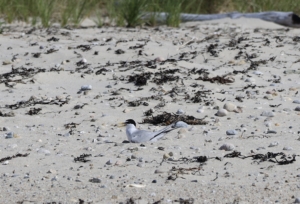As the summer progresses, the shorebird nesting season on island is winding down. This year’s monitoring included a mix of hopeful success and continued challenges. Here’s an overview of what we’ve seen so far, what remains, and how we can all play a role in protecting these sensitive species!
South Beach – Fencing Removal Coming Soon

Piping Plover pair with fledged chick Photo captured by Emma C.
This site hosted two Piping Plover pairs this year. One pair fledged a single chick, while the other successfully fledged two. These are encouraging signs, especially considering the vulnerability of these birds during the early chick-rearing phase. With fledging confirmed, we’ll be removing the symbolic fencing that has been protecting these nests.
Important note: Even after the fencing is taken down, please be mindful in this area. Fledged chicks often remain nearby for foraging and safety, and plovers are known to return to the same beaches year after year. Continued low-impact presence by beachgoers and staying on wet sand, avoiding flagged areas, and leashing dogs makes a real difference!
Big Club Beach – No Nesting Observed
This season, we saw no nesting activity here. A single plover was observed foraging, but it never established a territory or attempted to nest. The most likely cause? Repeated human disturbance. This beach, though really suitable in habitat, remains a high-traffic area. Without safe nesting space, plovers simply move on.
The fencing at this site will also be removed. While there were no active nests, continued public education and future monitoring remain critical. Restoring this beach as a viable nesting site will depend on all of us recognizing the signs and minimizing our impact!
Beach Pond (Behind the Oyster Farm) – Still Active & Vital

Least Tern nesting captured by Anna W.
Known formally by NYSDEC as “Beach Pond,” this remote site has become a key refuge for both terns and plovers. So far this year:
This site is unfenced due to its natural isolation and lack of public access, which reduces the risk of human-related disturbances. However, it is not free from threats… like gull predation. We have documented gulls interfering at the nest site, a common and difficult challenge for open-ground nesters like plovers and terns.
Eighth Hole Beach – Nesting Outside the Fence

4 Piping plover eggs (and a sneaky rock) captured by Anna W.
Here, a plover pair is attempting a second nest after an initial failure earlier this season. The symbolic fencing remains in place and will stay up until any chicks have safely fledged.
The new nest is located just outside the protected area, highlighting how nesting birds don’t always follow our boundaries. To adapt, we’ve marked the area with pink flags to signal nesting activity to beachgoers.
Please use caution when near this area. These nests are fragile and well-camouflaged. Even a single unintentional disturbance can cause adults to abandon their nest or lead predators directly to the eggs or chicks.
Mud Pond Beach (East Beach) – No Further Activity
After a failed nesting attempt in mid-June, no plovers have been seen at this site. It remains unfenced and inactive. While disappointing, this outcome isn’t unusual. Nesting success is heavily influenced by habitat conditions, predators, weather, and disturbances—all factors that fluctuate year to year.
This site will continue to be monitored in the seasons ahead. Even a site with no activity this year could become an important location in the future if conditions improve.
Stony Beach – Inactive Site
No Piping Plovers, no nests, and no activity observed during the entire season. This beach has remained quiet for plovers despite being historically suitable. We’ll continue to monitor it as part of our full island coverage.
This concludes our formal surveys for Piping Plovers, American Oystercatchers, Terns, Skimmers, Gulls, and Wading Birds, carried out in partnership with the New York State Department of Environmental Conservation (NYSDEC). Only a few active nests remain, and fencing at those sites will stay in place until the chicks have fully fledged!
We’ll continue to track those nests, and you may see team members conducting follow-up visits in the coming weeks.
What You Can Do

2 Least Tern eggs captured by Anna W.
Fishers Island is one of the few places where endangered and threatened coastal birds still have a chance to thrive. Every resident, visitor, and beachgoer plays a role in that success.
Here’s how you can help:
-
Respect fencing and signage. These protect active nests and give chicks the space they need.
-
Keep dogs leashed and avoid flagged or marked areas.
-
Stay on wet sand when walking along the beach.
-
Report unusual activity including predator sightings, off-leash dogs near nests, or unmarked nest scrapes.
Let’s continue working together to ensure these birds return next year and have the space and safety they need to raise their young.